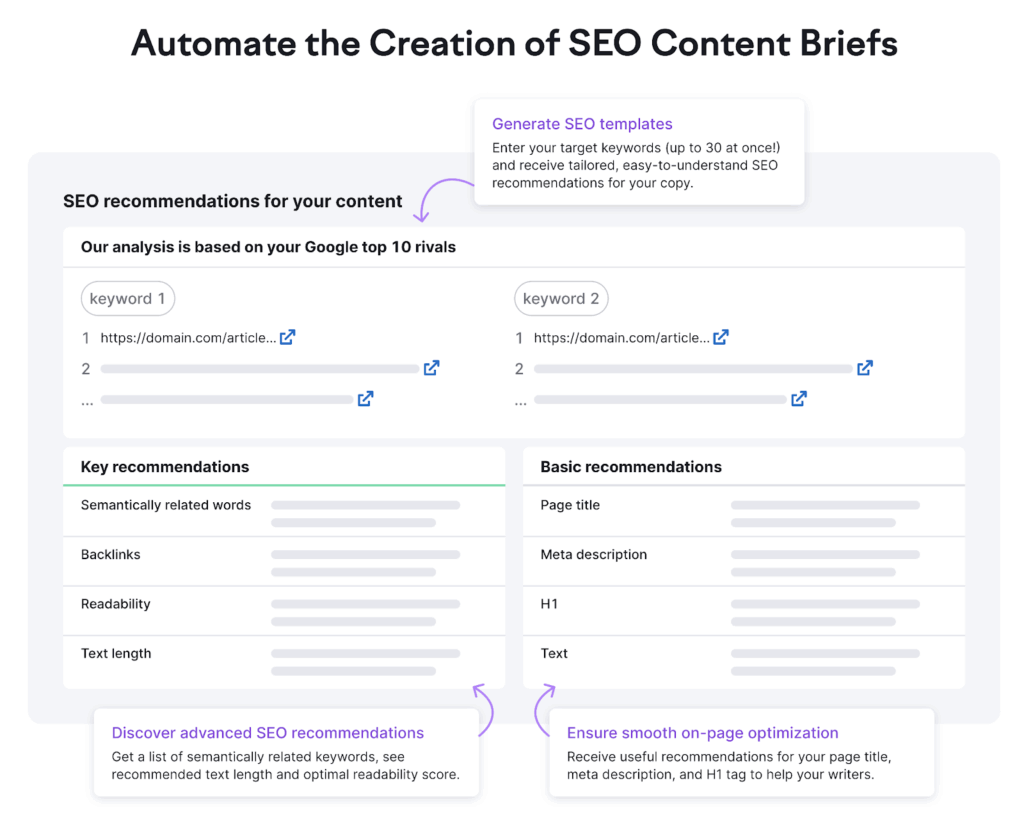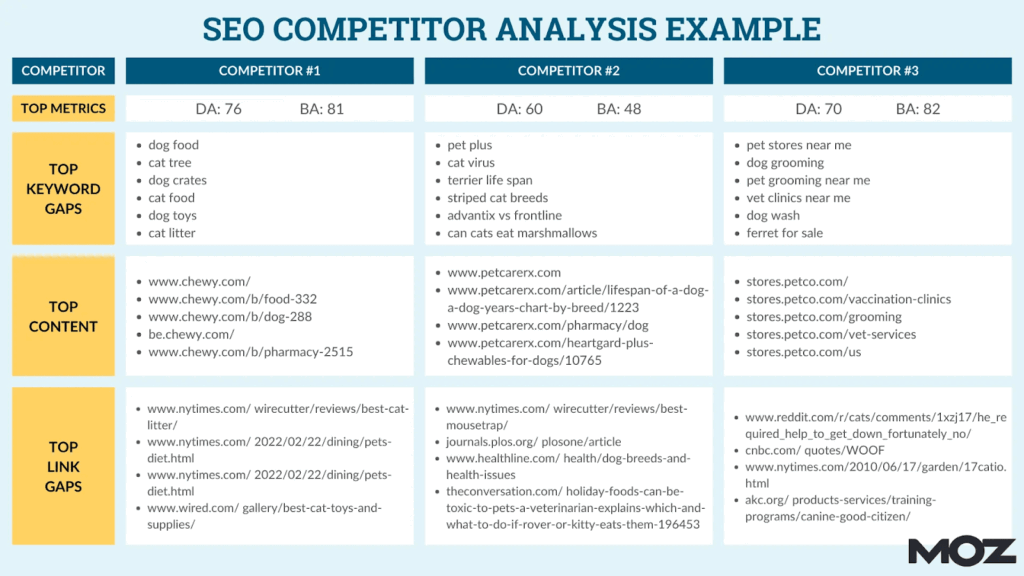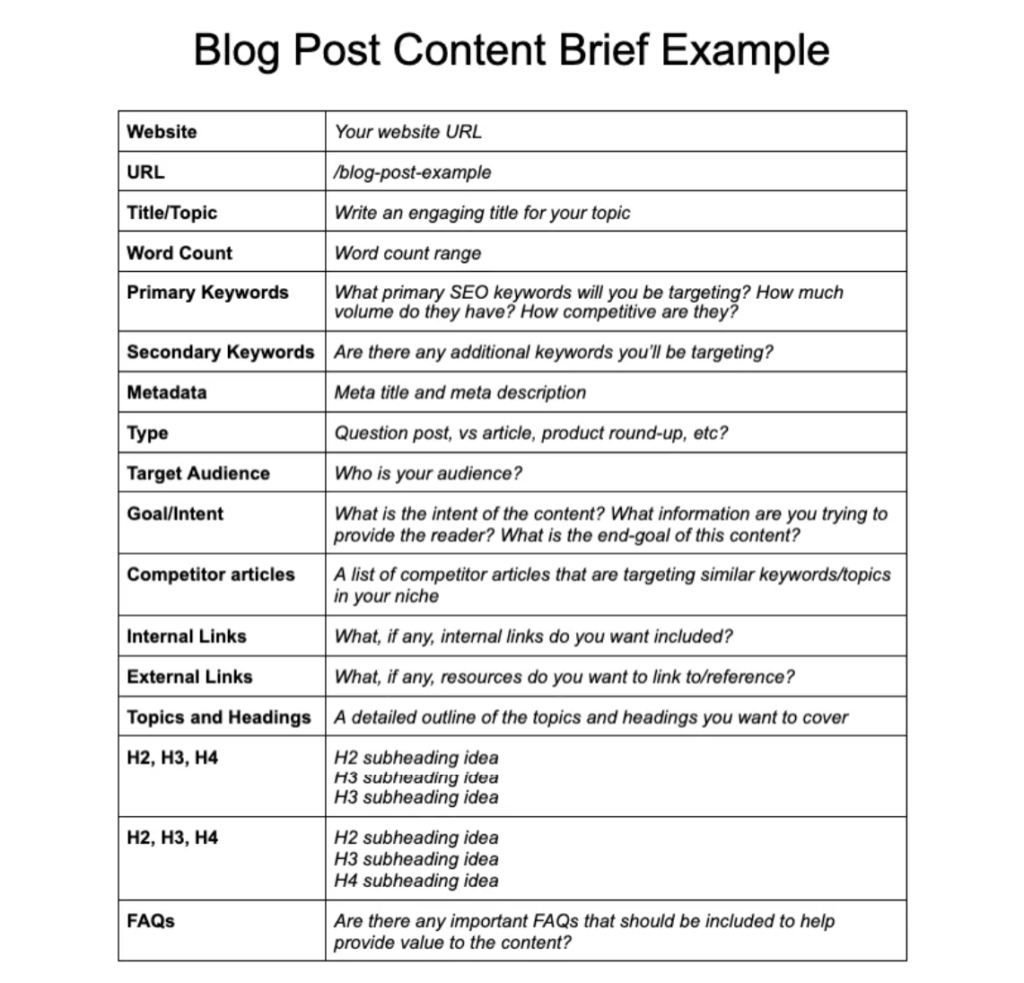
Every creator secretly loves a solid brief.
When they’re helpful, that is. 😂
Content briefs and SEO briefs are the real MVP of content creation because they guide creators on what to include and they help brands achieve their target goals.
But these need to be tailored a certain way in order to be useful. And that takes time and strategy.
In this guide, you’ll see what each of these briefs is, how they relate and differ, and when to use each one. We’ve also included handy checklists you can use to start preparing your content and SEO briefs this week!
Let’s take a look. 👇
A content brief is like a roadmap for making content.
It tells writers, designers, or video creators:
The focus is making sure the story fits the brand’s voice, connects with the audience, and works toward the content’s main goals. Social media creative agencies often rely on detailed content briefs to align teams, maintain consistency across campaigns, and ensure every piece of content supports the overall brand strategy.
Here’s a super simple content brief template you can reference:

(Image by Ioana)
An SEO brief is a technical, data-driven document focused on optimizing content for search engines.
It may include:
The goal is to get the most organic visibility and ranking potential.
You can actually automate your SEO content briefs. This is great because the automation will include all of the technical data your content needs, based on your goals.
Here’s an example of SEO brief creation automation by Semrush:

Here are the main similarities and differences when comparing content briefs vs. SEO briefs:
Here’s what both briefs tend to cover:
Here are the main differences between content briefs and SEO briefs:
Content briefs prioritize messaging, storytelling, brand voice, audience journey, and what the piece should feel like and achieve.
SEO briefs prioritize search visibility and ranking. This includes search intent, target keywords, meta tags, schema, SERP features, impressions, and CTR goals.
Content briefs are written for writers, designers, and video teams who produce the creative work.
SEO briefs are for SEO specialists, technical writers, SEO content writers, and developers who implement keyword strategy and technical tweaks.
Content briefs suggest natural, semantic keywords to keep copy readable and on-brand.
SEO briefs list exact-match keywords, keyword variations, LSI keywords (Latent Semantic Indexing keywords, placement rules, and sometimes density goals to target search queries.

Content briefs may note a headline or meta description angle for brand alignment.
SEO briefs give precise instructions. For example, they might include: Title tags, header structure, schema markup, alt text, canonical tags, and an internal linking strategy.
Content briefs highlight thematic gaps and unique angles.
SEO briefs dig into SERP feature analysis, keyword difficulty, top-ranking pages, backlink context, and set measurable ranking targets.
Here’s a very detailed example of an SEO competitor analysis by Moz. (Yours doesn’t have to be this intricate.)

Content briefs focus on reader value and funnel stage when advising depth.
SEO briefs often prescribe word counts and structural elements based on what ranks.
Content briefs frame CTAs for brand/campaign goals.
SEO briefs place CTAs to capture search-driven conversions and micro-conversions.
Content briefs set the tone, voice, and creative direction.
SEO briefs are more prescriptive and technical. (It’s a checklist you must hit for SEO performance.)
Here’s a handy chart you can reference to remember the differences between a content brief and an SEO brief. 👇
*Note: Not every brief will contain all of the data listed below. Brief data can vary depending on the publisher or content agency (or whoever’s) supplying them.
| Dimension | Content Brief | SEO Brief |
|---|---|---|
| Primary User | Writers, editors, content strategists | SEO specialists, technical writers |
| Core Focus | Messaging, storytelling, tone, engagement | Search visibility, keyword optimization, ranking |
| Keyword Usage | Suggested natural keywords or semantic keywords | Exact match keywords, variations, keyword density, LSI keywords |
| On-Page SEO Elements | May mention meta description or title for brand alignment | Detailed meta tags, schema markup, alt text instructions |
| Competitor Analysis | High-level thematic gaps, unique angles | In-depth SERP feature analysis, keyword difficulty, backlink context |
| Content Metrics | Engagement, readability, shareability | Search impressions, CTR, ranking potential |
| Length & Depth Guidance | Focus on reader value, brand storytelling, and funnel stage | Often prescriptive with word count based on competitor analysis |
| Calls to Action (CTA) | Emphasizes brand and campaign goals | Focuses on SEO funnel conversion points |
➜ Use a content brief when your focus is brand storytelling, thought leadership, or engagement that goes beyond search traffic.
This type of brief is ideal if your audience includes non-technical stakeholders like PR, social, or sales teams who care more about voice and messaging than technical details.
Content briefs are also helpful for formats that require creativity and nuance, like blog posts or videos. They help you make sure every piece of content aligns with your brand tone and style guide, while still leaving room for some creative freedom.
Here’s a detailed example of a blog content brief by SODP:

➜ Use an SEO brief when your priority is driving organic search rankings and traffic through precise keyword targeting.
This kind of brief is best for data-driven, competitive content. For example, product pages, blog posts, and service descriptions. It’s also very helpful for informational hubs where search visibility matters most. These include help centers and knowledge bases.
SEO briefs also cover technical elements like on-page compliance, schema markup, and structured data.
(They’re especially valuable when briefing writers who need exact keyword rules, densities, and SEO checklists to follow to get the best performance in search results.)
Many organizations combine both brief types or use them sequentially.
For example, they might start with an SEO brief to define keywords, the competition, and technical needs. And then layer on a content brief for storytelling and brand tone.
Here’s a preview of what that might look like:
(Note that this is just to give you an idea — it’s not a comprehensive hybrid brief.)

This hybrid approach helps you create relevant content for your target audience and optimized for search engines.
Just make sure to coordinate with the right departments or team members to prevent conflicting instructions.
You can also provide team members with two separate briefs. But again, make sure they complement each other. (Don’t have one target keyword on your SEO brief, and a title that targets a different term in your content brief.)
➜ Both briefs should align on search intent, a target keyword, and a main content goal.
The preparation process looks slightly different depending on whether you’re building a content brief or an SEO brief.
Here’s how to write both kinds. 👇
Start with your target audience.
Define your buyer persona and explain what the piece should achieve (awareness, thought leadership, engagement, or conversion).

From there:
Think of your content briefs as creative briefs for digital marketing. They guide content writers, freelance creators, and design teams to stay consistent with your brand voice, while giving them enough freedom for storytelling.
SEO briefs are more data-driven.
Start with keyword research tools like Ahrefs, Semrush, or AnswerThePublic to pull target keywords and related variations.
Then:
Where content briefs leave room for creativity, SEO briefs act more like a technical checklist. They tell the marketer and strategist exactly what must be in place for the content to rank.
Content briefs and SEO briefs both play a huge role in successful content marketing. One gives you clarity on brand voice and storytelling. The other helps you make sure your content shows up in search engine results pages.
When you use them together, you create content that connects with your audience AND ranks in Google.
The key takeaway: Don’t choose between creativity and optimization. Build a process where your briefs complement each other so every content project leads to measurable results.
By the way …
👉 Want to speed up publishing once your briefs turn into full drafts? Try Wordable.
It lets you export content from Google Docs straight into your CMS, so it’s formatted, optimized, and ready to go. Saves hours each week!
GET STARTED WITH WORDABLE NOW.
What is the difference between a content brief and an SEO brief?
A content brief focuses on storytelling, tone, and audience engagement, while an SEO brief is centered on keyword optimization and technical search requirements.
Do I need both a content brief and an SEO brief?
Ideally yes. Combining both helps you make sure your content is engaging for readers and optimized for search engines. (The content marketing sweet spot.)
Can one document serve as both a content brief and an SEO brief?
Yes, one document can serve as both a content brief and an SEO brief. Just make sure to include clear sections to avoid confusion, and that both creative and technical needs are fully explained.
How detailed should an SEO brief be?
Your SEO brief should include precise keyword targeting, meta tags, content structure, and technical SEO instructions relevant to the content piece.
Can AI tools help create content briefs?
Yes. In fact, 27% of content marketers use AI tools to help streamline their content brief workflows (Source: Demandsage). Tools like Surfer and Frase are perfect for helping generate content and SEO briefs.
Who should write content briefs and SEO briefs?
Content strategists or marketers should write content briefs. SEO specialists or analysts should write SEO briefs. Sometimes there’s an overlap in roles. For example, an SEO content strategist has enough expertise and experience to prepare both types of briefs.
How does user intent factor into content and SEO briefs?
In content briefs, you address emotional and informational needs to line up with user intent. In SEO briefs, you focus on matching search intent types (informational, transactional, navigational).
Can ignoring SEO briefs hurt my content’s performance?
Yes, ignoring SEO briefs can hurt your content’s performance. Content without SEO guidance often ranks poorly and gets less organic traffic.
What tools can help create effective SEO briefs?
Tools like Ahrefs, Semrush, and Clearscope can help you with keyword research and competitive analysis when preparing your SEO briefs.
How often should content and SEO briefs be updated?
Update your content and SEO briefs regularly — ideally after analyzing content performance and SEO trends. (You may need to refresh cornerstone content more often than other pieces to stay competitive in the SERPs.)
Should SEO briefs include competitor analysis?
Yes, SEO briefs should include competitor analyses. Your SEO briefs need to include competitor rankings, keyword gaps, and SERP features that inform your optimization strategy.